Tango no Sekku
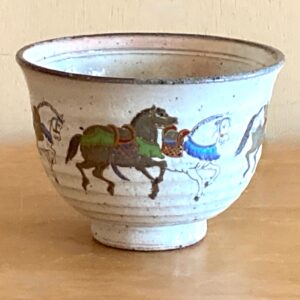
Tan-go no Se-kku, 端午の節句, Begin-(zodiac) horse’s Season-phase, was originally a day when women purified the house by thatching the roof above the entrance to the house, with shō-bu, 菖蒲, iris-rush, and yomogi, 蓬, mugwort, artemisia. These herbs are said to be beneficial for healing, and in the past were believed effective in repelling evil spirits, and for women to rest their bodies. The bundle of iris and mugwort was also put in the soaking bath, fu-ro, 風呂, wind-spine, shō-bu-yu, 菖蒲湯, iris-rush-hot water. Later, in the Kama-kura, 鎌倉, Sickle-storehouse, period (1185–1333), Tango no Sekku was changed to a day for boys when the samurai class took control of the government. One reason is that the iris leaf looks like the blade of a Japanese sword. Also, a word for iris is shō-bu, 菖蒲, iris-rush, which is a homonym for shō-bu, 尚武, esteem-war.
Introduced at this time, was the warrior-valued yabusame, 流鏑馬, flow-‘turnip’-horse, horseback archery. The number 5, five in Japanese is go, 五, and a homonym for go, 午, the zodiac sign of the uma, 馬, horse. The double 5, 5th day of the 5th month according to the lunar calendar, was auspicious and could ward off inauspiciousness. It may be coincidence that when using the furo handling the hi-shaku, 柄杓, handle-ladle, is likened to the handling of a bow and arrow. In addition, the word sho-bu-ro, 初風炉, first-wind-hearth, is a modified wordplay on shō-bu-yu, 菖蒲炉, iris-rush-hearth, as irises bloom about when the furo is used for the first time in the year.
These events were established according to the lunar calendar so that the 5th day of the 5th month varies each year, but occurs about one month after May 5. In 2024, the lunar 5th day of the 5th month occurs on June 10, which is the day to observe Nyū-bai, 入梅, Enter-Japanese apricot, which is synonymous with the start of the rainy season.
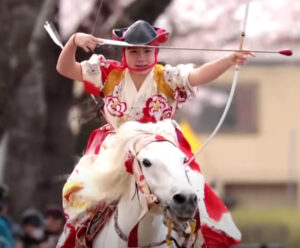
Horseback archery in Japanese is called yabusame, and is written with the Kanji, 流鏑馬, which are read ryū-teki-ba, flow-‘turnip’-horse, and are not read as yabusame. The Japanese Kanji that are read yabu-same, are 藪雨, which means ‘thicket-rain’, and may also refer to the start of the rainy season. To complicate matters, the standard meaning of yabu-same, 藪雨, thicket-rain, is a bird called the Asian stubtail, Urosphena squameiceps, a type of Old-World warbler. As is often the circumstance, the names of some things, especially those in nature, are derived from the song or sound that a creature might make, or from a specific purpose, and subsequently the name is written in katakana, such as yabusame is written ヤブサメ. The song of the yabusame warbler is likened to the sound of light rain falling on leaves, but in actuality, its song sounds more like a tiny cicada or cricket, and with not much tone.
The Kanji 鏑 in yabusame, 流鏑馬, is also read kabura, which means ‘turnip’-shaped whistle made of hollowed-out wood or deer horn attached to an arrow to sound when fired, and also to start a battle. It is curious that the radical for ‘turnip’, 鏑, is metal, 金, as the kabura is made of wood or horn. There are different forms of kabura, including that pictured, which resembles the form of a cha-ire, 茶入, tea-container. The Kanji for kabura, 鏑, has the same right side of the Kanji, teki, 適, drip, as in abura-teki, 油適, oil-drip. The abura-teki is one of four ceramic tea containers, shi-teki, 四適, four-drip, that have forms that keep them from being used as containers for koi-cha, 濃茶, thick-tea.
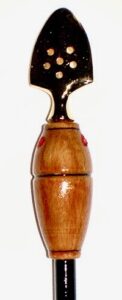
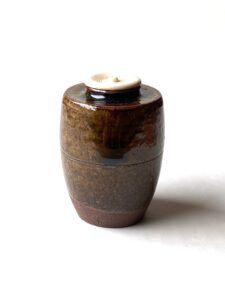
Both objects, the wooden kabura and the ceramic jar are made by turning on a lathe or potter’s wheel.
The Buddha, in a contest to win his wife, shot an arrow farther than any of her other suitors, and could pull the bowstring that others could not. Where the arrow struck the earth, a spring of water gushed forth.

The kabura, 鏑, ‘turnip’, is a small device attached below the tip of an arrow. They vary in size and form, but are generally cylindrical, conical, or spindle-shaped, and is made of wood such as hō, 朴, magnolia, and kiri, 桐, paulownia, bamboo, or deer antler. The object is hollow with a few holes, and is usually wrapped with thread, ito-maki, 糸巻, thread-wrap, to help prevent it from cracking. In battle, the arrow tip may be removed leaving the kabura to sound the advance of an attack.
It should be noted that the ito-maki, thread wrapped around the kabura, may be likened to the dō-himo, 胴紐, body-cord, the slight indentation around the middle of some chaire, such as the chaire pictured.
The nuta-me, 觘目, (?)–eye, refers to the holes in the top of the kabura of an arrow. The holes cause a sound when the arrow flying through the air. The sound may be likened to a sudden hoo around middle C, and not like the continuous tiny chirp of the stubtail warbler.
The kami, Su-sa-no-o no Mikoto, 須佐之男命, Necessarily-help-’s-male-lord, brother of Amaterasu, is often depicted with bow and arrow. He flayed the Ame no Fuchi-koma, 天の斑駒, Heaven’s Spotted-colt, and threw the pelt into her weaving chamber.
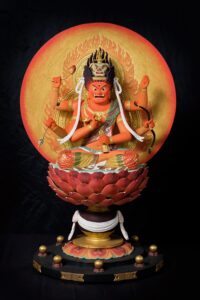
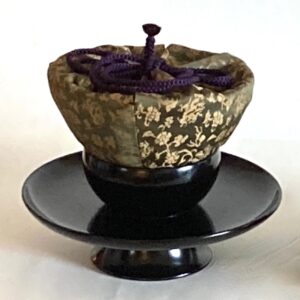
One of the most revered Buddhist guardians is Ai-zen Myō-ō, 愛染明王, Love-imbued Bright-king. Aizen Myō-ō, together with the leader of the Bright Kings, Fudō Myō-ō, 不動明王, No-move Bright-king, are manifestations of Dai-nichi Nyo-rai, 大日如来, Great-sun Like-become, the universe made manifest. Aizen’s ferocious demeanor is to ward off undesirable passions but nurtures true love. He carries various implements including a bow and arrow, on which the artist added a sound-making black kabura, 鏑, ‘turnip’, to the arrow. Note the lion head on the crown of Aizen. The entire figure and base may evoke the form of the Dai-ten-moku cha-wan, 台天目茶碗, Great-heaven-eye tea-bowl, and stand. Praise to an artist who maintains the finest creative Japanese tradition.

